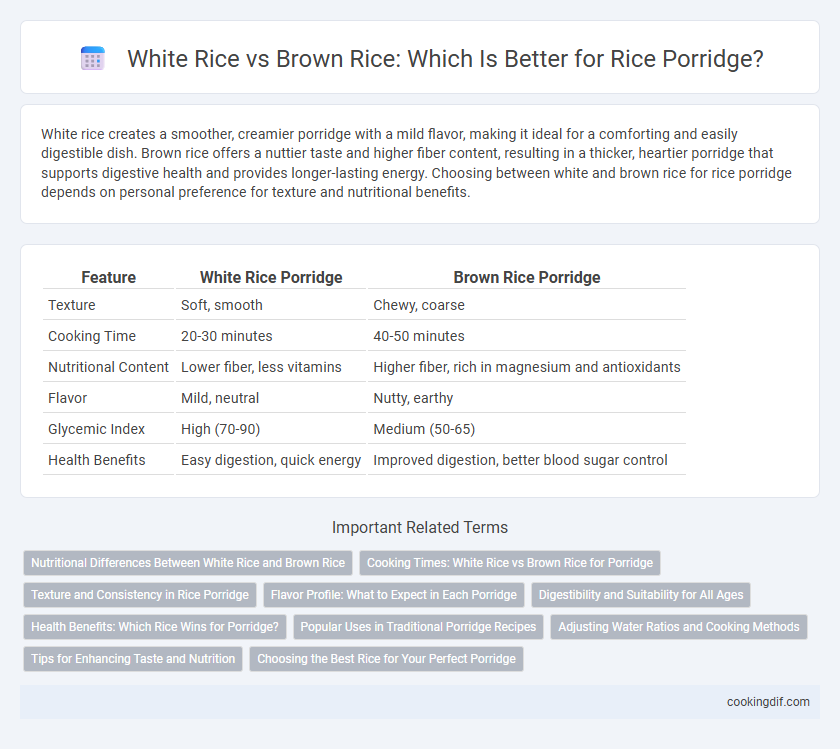White rice creates a smoother, creamier porridge with a mild flavor, making it ideal for a comforting and easily digestible dish. Brown rice offers a nuttier taste and higher fiber content, resulting in a thicker, heartier porridge that supports digestive health and provides longer-lasting energy. Choosing between white and brown rice for rice porridge depends on personal preference for texture and nutritional benefits.
Table of Comparison
| Feature | White Rice Porridge | Brown Rice Porridge |
|---|---|---|
| Texture | Soft, smooth | Chewy, coarse |
| Cooking Time | 20-30 minutes | 40-50 minutes |
| Nutritional Content | Lower fiber, less vitamins | Higher fiber, rich in magnesium and antioxidants |
| Flavor | Mild, neutral | Nutty, earthy |
| Glycemic Index | High (70-90) | Medium (50-65) |
| Health Benefits | Easy digestion, quick energy | Improved digestion, better blood sugar control |
Nutritional Differences Between White Rice and Brown Rice
Brown rice offers higher fiber content and essential nutrients like magnesium, phosphorus, and B vitamins compared to white rice, making it a more nutrient-dense option for rice porridge. White rice, having undergone polishing and milling, has a softer texture and quicker cooking time but contains fewer vitamins and minerals due to the removal of the bran and germ. Choosing brown rice for porridge enhances satiety and supports better digestive health due to its complex carbohydrates and intact nutrient profile.
Cooking Times: White Rice vs Brown Rice for Porridge
White rice typically requires a shorter cooking time of about 20-30 minutes to achieve a smooth porridge consistency, while brown rice needs 45-60 minutes due to its intact bran layer. The longer cooking time for brown rice allows it to release more fiber and nutrients, resulting in a heartier texture and richer flavor. Adjusting liquid ratios and pressure cooking can optimize cooking times for both types in rice porridge preparation.
Texture and Consistency in Rice Porridge
White rice creates a smoother and creamier porridge due to its softer starch composition, resulting in a velvety texture that easily breaks down during cooking. Brown rice provides a heartier and chewier consistency, owing to its intact bran layer, which contributes to a more fibrous and slightly grainy porridge. The choice between white and brown rice significantly impacts the porridge's mouthfeel, with white rice preferred for a delicate, silky experience and brown rice favored for a more substantial, textured porridge.
Flavor Profile: What to Expect in Each Porridge
White rice porridge offers a delicate, mildly sweet flavor and a creamy, smooth texture that enhances the comfort of the dish. Brown rice porridge presents a nuttier, earthier taste with a slightly chewy texture, providing a heartier and more textured eating experience. The choice between white and brown rice affects the porridge's flavor intensity and mouthfeel, influencing overall satisfaction.
Digestibility and Suitability for All Ages
White rice porridge offers higher digestibility due to its lower fiber content, making it suitable for all age groups including infants and the elderly with sensitive digestive systems. Brown rice porridge contains more fiber and nutrients but may be harder to digest, potentially causing discomfort in young children or those with digestive issues. Choosing between white and brown rice porridge depends on the individual's digestive health and nutritional needs.
Health Benefits: Which Rice Wins for Porridge?
White rice porridge offers a smoother texture and quicker digestion, making it ideal for light meals or recovery diets. Brown rice porridge contains higher fiber, vitamins, and antioxidants, supporting better digestion and sustained energy release. For optimal health benefits in rice porridge, brown rice ranks superior due to its nutrient density and positive impact on blood sugar regulation.
Popular Uses in Traditional Porridge Recipes
White rice is commonly preferred for rice porridge due to its soft texture and ability to break down quickly, creating a smooth and creamy consistency ideal for traditional congee and similar dishes. Brown rice, with its higher fiber content and chewier texture, is popular in health-focused porridge recipes, offering a nuttier flavor and more nutritional benefits. Traditional Asian porridge recipes primarily use white rice for its ease of digestion, while modern variations incorporate brown rice to enhance dietary fiber and antioxidants.
Adjusting Water Ratios and Cooking Methods
White rice porridge requires a higher water-to-rice ratio, typically around 6:1, to achieve a smooth, creamy texture, while brown rice porridge demands even more water, approximately 8:1, due to its fibrous bran layer. Cooking brown rice porridge often involves longer simmering times or pre-soaking to soften the grains adequately and enhance digestibility. Adjusting water ratios and extending cooking durations are crucial for obtaining the desired consistency and flavor in both white and brown rice porridges.
Tips for Enhancing Taste and Nutrition
White rice creates a smoother and creamier porridge texture, while brown rice offers higher fiber and essential nutrients for better digestion and sustained energy. To enhance taste and nutrition, soak brown rice before cooking to reduce cooking time and improve softness, and add spices like ginger or cinnamon to enrich flavor and aid digestion. Incorporate protein sources such as nuts, seeds, or legumes to balance the meal and boost its nutritional profile.
Choosing the Best Rice for Your Perfect Porridge
White rice creates a silky, smooth texture ideal for traditional rice porridge, while brown rice offers a nuttier flavor and higher fiber content for a heartier, more nutritious option. Choosing between them depends on whether you prioritize creaminess and digestibility or fiber and antioxidants for your perfect porridge. Consistently selecting short-grain varieties enhances porridge consistency, regardless of rice type.
White Rice vs Brown Rice for Rice Porridge Infographic

 cookingdif.com
cookingdif.com